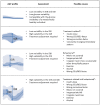Clinical Recommendations for the Use of the Ambulatory Glucose Profile in Diabetes Care
- PMID: 31718268
- PMCID: PMC7576939
- DOI: 10.1177/1932296819883032
Clinical Recommendations for the Use of the Ambulatory Glucose Profile in Diabetes Care
Abstract
Background: The ambulatory glucose profile (AGP) uses the wealth of data that are generated by continuous glucose monitoring, including flash glucose monitoring technologies, to provide a visual representation of glucose levels over a typical standard day of usually the most recent two weeks for a person with diabetes and helps to identify patterns and trends in glucose control. The AGP allows certain patterns of glucose levels to be identified and analyzed, such that treatment adjustments can be made, and new individual treatment goals can be defined. This helps to ensure increased treatment satisfaction and adherence, quality of life, and an improvement in metabolic management for people with diabetes.
Objective: To date, a range of approaches exists for interpreting the information contained in an AGP, with different priorities given to identifying and targeting patterns of hypoglycemia and the degree of variability and stability underlying the glucose levels. The objective of the present recommendation is to describe the steps for assessing an AGP in detail and to illustrate these steps using visual examples.
Conclusion: This paper describes the consensus recommendations from a group of German expert diabetologists on the necessary steps for assessing an AGP in a structured and detailed way and to explain these steps using practical clinical examples.
Keywords: AGP; CGM; ambulatory glucose profile; continuous glucose monitoring; diabetes self-management; diabetes therapy; flash glucose monitoring; glycemic control; glycemic stability; glycemic variability; hypoglycemia; isCGM; rtCGM.
Conflict of interest statement
Figures





References
-
- Mazze RS, Lucido D, Langer O, et al. Ambulatory glucose profile: representation of verified self-monitored blood glucose data. Diabetes Care. 1987;10(1):111-117. - PubMed
-
- Mazze RS, Strock E, Wesley D, et al. Characterizing glucose exposure for individuals with normal glucose tolerance using continuous glucose monitoring and ambulatory glucose profile analysis. Diabetes Technol Ther. 2008;10(3):149-159. - PubMed
-
- Matthaei S. Assessing the value of the Ambulatory Glucose Profile in clinical practice. Br J Diab Vasc Dis. 2014;14(4):148-152.
-
- Matthaei S, Dealaiz RA, Bosi E, et al. Consensus recommendations for the use of Ambulatory Glucose Profile in clinical practice. Br J Diab Vasc Dis. 2014;14(4):153-157.
Publication types
MeSH terms
Substances
LinkOut - more resources
Full Text Sources
Other Literature Sources
Medical

